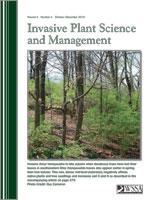This paper describes postrelease monitoring of a population of Jaapiella ivannikovi, a gall-forming midge that was introduced for biological control of Russian knapweed. In 2011 to 2013, from late May to early June through August, we monitored 100 permanent plots at one of the first release sites of J. ivannikovi in central Wyoming. Based on the phenology of gall formation, an appropriate window for collection of galls to distribute to new sites is from early to mid-June through early August. Although J. ivannikovi established successfully, 4 yr after release, the percentage of ramets that were galled remained low (1 to 2%), indicating that J. ivannikovi is not yet having a significant effect on Russian knapweed at the site.
Nomenclature: Russian knapweed, Acroptilon repens (L.) DC., ACRE3.
Management Implications: A new biological control agent for Russian knapweed, the gall forming midge Jaapiella ivannikovi was permitted and first released in the U.S.A. in 2009. We addressed two questions of interest to weed managers utilizing J. ivannikovi for Russian knapweed management. What is the appropriate time to collect galls for release at new sites? Is J. ivannikovi having an impact on Russian knapweed four years after release? From 2011-2013, we monitored Russian knapweed ramets (annually) and J. ivannikovi galls (weekly). We also determined emergence times of adult midges by caging galls.
Gall formation occurred from late-May or early-June to mid-August and peaked in early July in 2011 and 2013; there was no clear peak in 2012. Adult midges emerged most frequently from galls between two and three weeks after a gall was first observed. Our results therefore suggest that an appropriate window for collection of galls for release at new sites is from early- to mid-June, about two weeks after galls first appear, through early-August.
Across the three years of monitoring, J. ivannikovi populations were relatively low. Russian knapweed ramet (main shoot) densities were relatively constant across years, and most (98%) Russian knapweed ramets escaped attack by J. ivannikovi. Our results suggest that J. ivannikovi’s impacts, if they do ultimately occur, are likely to take longer than the four years that J. ivannikovi has been present at our site.





